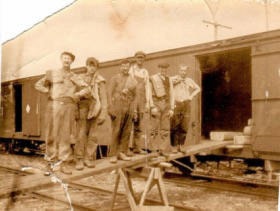Throughout much of the first half of the 20th Century, many local residents earned their living hacking ties for the railway.
While it could be a lucrative occupation, tie hacking wasn’t an easy one. The men and women who made their living cutting railway ties by hand with a broad axe were tough beyond imagination.
A typical day in the life of a tie-hacker went something like this:
Imagine a cold January morning in Palling in 1925. Light snow is falling. It’s not yet dawn, but you’ve already been up for some time. After a quick breakfast of oatmeal ‘mush’ cooked over a tin stove, you pull heavy wool pants over the long Stanfield underwear you almost never take off, then don a shirt, coat, and knit toque before leaving the comfort of your 8’ x 12’ cabin for a day in the pines.
Your life is a solitary one. You’re frequently lonely and almost always tired. You sometimes envy people like Ed and Edith Miller (and Jeff and Eva Neville), because they work together and thus have company, but a fellow’s got to do what he can to make a living.
And right now, there’s money to be made tie-hacking. Plenty of railway construction these days, and many of the ties originally used to construct the Grand Truck Pacific Railway through Northern BC have rotted and need replacing. Because of this, demand for things is high; a well-hewn, eight-foot 9x7 can fetch as much as $.55.
Doesn’t seem like a lot of cash, but if you work hard, you can make good wages. Sure, you might not be able to cut 50 a day like your neighbour Carl Holmgren, but Carl and others like Pete Holt have been doing it since the early ‘20s. You’re aiming for two or three dozen ties a day, and you think it’s achievable now that you’ve got some instruction from Carl and another tie hacker named Clarke Anderson. They’ve taught you how to swing the heavy broad axe efficiently and pace yourself so you can put in a full day and still get up the next morning.
Today you hope to cut a dozen or so ties, then hitch your horses to the heavy tie sled and haul the ‘fruits of your labour’ to Palling Station. You pray there will be a loading crew there, because you don’t like carrying ties into the Grand Truck’s boxcars on your shoulders. Even with a thick woolen pad set atop your collarbone, the loading process always leaves you bruised and exhausted. Besides, train loading takes time – time would be better spent falling more trees and hacking more ties.
The most ties ever hauled to the Palling Station in one trip is 200. You won’t be able to match that total today, because your production isn’t up to snuff and ‘the old grey mares’ pulling the tie sled ain’t what they used to be.
You swing the axe steadily throughout the morning, striving for that smooth, easy rhythm that comes so naturally to Carl and the other veterans. You don’t take many breaks, because as Benjamin Franklin once said, “time is money.” If you were a betting man, you’d wager that old Ben never hacked ties for a living.
Around noon, you put down your axe long enough to eat a cheese sandwich and take few swallows of cold coffee. You wish there was something stronger in the mason jar, but you know from experience that alcohol consumption reduces production and leads to injuries. Besides, can’t stop work for long, because when you do, your sweat-soaked clothing draws the January cold like a magnet.
Ten minutes later, you pick up the axe and start another tie. As the afternoon wears on and the snow gets deeper, you realize you won’t be making that trip to Palling Station today. Maybe tomorrow, if it stops snowing. Be good to take a bit of a break, because you’ve been in here on your own for two weeks straight. Much longer, and you might get cabin fever, go a bit crazy like that Finlander out at Trout Creek. That wouldn’t be good.
In late afternoon, as the light begins to fade, you shoulder your axe, grab your grub sack, and trudge back to the cabin. You’re tired, but the work is getting easier. You cut 32 ties today, which equates to about $16 at the Palling Station. Not a bad day’s work when you consider that $3.50 will buy a loaf of bread, a block of cheese, a pound of bacon, and a tin of coffee at the store in Decker Lake.
You throw some kindling on the fire and open the stove vent. You’d like to sit a spell, but there’s still the horses to feed and water, and a quick meal to make and eat. It’s still snowing outside the cabin when you blow out the lantern at 8 p.m. and crawl beneath the blankets on your homemade bunk. Sleep comes quickly, which is fortunate, because tomorrow morning, you get to do the same thing over again.
© 2018 Michael Riis-Christianson and the Lakes District Museum Society
